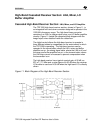
SWRA004A
TRF1500 Integrated Dual-Band RF Receiver User’s Guide 41
2) Set the LO source power (LO P
in
) and the desired frequency
(see Table 4). Connect the LO source to the EVM LO input
port, J12.
3) Set the spectrum analyzer to measure at the IF frequency (see
Table 4).
4) Connect the EVM IF output port, J21, to the spectrum
analyzer.
5) Measure the IF output power (IF P
out
) at the IF frequency with
the spectrum analyzer.
6) Calculate the Cascaded Gain as:
Gain = (IF P
out
- RF P
in
) + Transformer Loss. The
transformer loss is 1.8dB.
High-Band Cascaded: Power Conversion Gain Reduction
Control state: 111011
SEE APPENDIX A: TEST BENCH SETUPS
Test setup Figure 20
The Power conversion gain reduction is the delta between the
cascaded IF Pout and the strong signal IF Pout when the strong
signal is enabled. Enabling the strong signal turns off the LNA. It is
measured using a RF source and a spectrum analyzer.
1) Set the RF source power (RF P
in
) and the desired frequency
(see Table 4). Connect the RF source to the EVM RF input
port, J20.
2) Set the LO source power (LO P
in
) and the desired frequency
(see Table 4). Connect the LO source to the EVM LO input
port, J12.
3) Set the spectrum analyzer to measure at the IF frequency (see
Table 4).
4) Connect the EVM IF output port, J21, to the spectrum
analyzer.
5) Measure the output power at the IF frequency (IF P
out
) with the
spectrum analyzer.
6) Enable the strong signal. Measure the output power at the IF
frequency (SS IF P
out
) with the spectrum analyzer.
7) Calculate Power conversion gain reduction as:
Power Conversion Gain Reduction = (IF P
out
- SS IF P
out
).


















